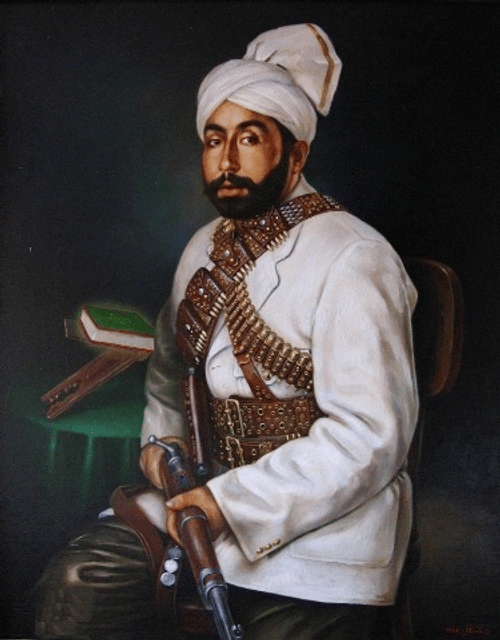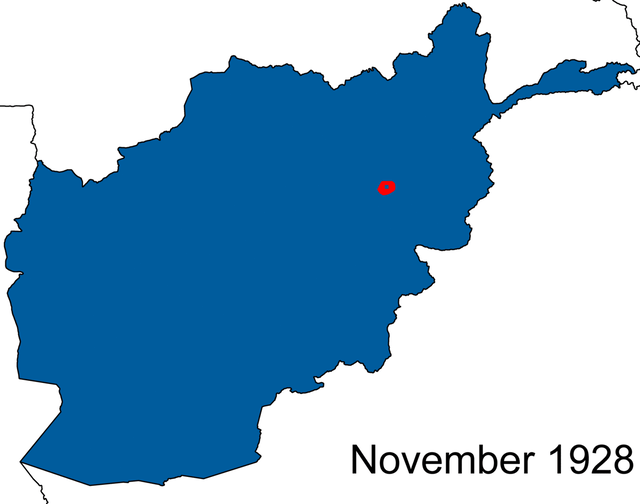Habibullāh Kalakāni

Habibullāh Kalakāni

| Habibullah Kalakani حبیبالله کلکانی | |||||
|---|---|---|---|---|---|
| List of monarchs of Afghanistan | |||||
| King of Afghanistan | |||||
| Reign | 17 January 1929[1] – 13 October 1929 | ||||
| Coronation | 17 January 1929 | ||||
| Predecessor | Inayatullah Khan | ||||
| Successor | Mohammed Nadir Shah | ||||
| Born | 19 January 1891 Kalakan, Kabul Province | ||||
| Died | 1 November 1929(1929-11-01)(aged 38) Kabul, Kabul Province | ||||
| |||||
| Father | Aminullah Kalakani | ||||
| Religion | Islam | ||||
| Full name | |||||
| Habibullah Kalakani | |||||
Habibullah Kalakani (Dari: حبیبالله کلکانی), (19 January 1891 – 1 November 1929), was a King of Afghanistan who ruled from 17 January 1929[1] to 13 October 1929. He was an ethnic Tajik. He was named ( Habibullah Khadem-e Din-e Rasulallah).
During the Afghan Civil War (1928–1929), he contested the Afghan throne with Amanullah Khan.[5] After defeating Amanullah, he was eventually defeated by Mohammed Nadir Shah.[5] Khalilullah Khalili, a Kohistani poet laureate, depicts King Habibullah Kalakani as the "best manager of governmental imports and exports".[6].
| Habibullah Kalakani حبیبالله کلکانی | |||||
|---|---|---|---|---|---|
| List of monarchs of Afghanistan | |||||
| King of Afghanistan | |||||
| Reign | 17 January 1929[1] – 13 October 1929 | ||||
| Coronation | 17 January 1929 | ||||
| Predecessor | Inayatullah Khan | ||||
| Successor | Mohammed Nadir Shah | ||||
| Born | 19 January 1891 Kalakan, Kabul Province | ||||
| Died | 1 November 1929(1929-11-01)(aged 38) Kabul, Kabul Province | ||||
| |||||
| Father | Aminullah Kalakani | ||||
| Religion | Islam | ||||
| Full name | |||||
| Habibullah Kalakani | |||||
Early years
Habibullah Kalakani was born in either 1891[7] or 1870[8] in the village of Kalakan,[9] north of Kabul. He was an ethnic Tajik. In his memoirs, Kalakani stated that his home village was "miserable" and that he had "conceived a deep hatred of its poverty-stricken exterior".[10] At age 14, he left for Kabul on horseback with his friends Nur and Jamal.[10] Later, he joined King Amanullah Khan's army, and fought in the Third Anglo-Afghan War and the Khost rebellion of 1924. During the latter war, he served as officer with the Royal Army's "Model Battalion" and served with distinction during the suppression of the insurgents.[11] Nevertheless, he deserted the unit at some unspecified time, and after working in Peshawar moved to Parachinar (on the Afghan border) where he was arrested and sentenced to eleven months imprisonment.[12]
Thereafter, Kalakani began a life of Banditry, since he considered the occupations common among the Kuhdamanis, like viticulture and selling firewood, to be beneath him, reasoning that these could hardly ever provide wheat bread for his table. Instead, he began to rob caravans and nearby villages. He was joined by Sayyid Husayn and Malik Muhsin, as well as others, totaling 24 in all. For three years, they lived in mountain caves, venturing out during the day to rob and hiding out at night, all the time fearful of government retaliation. Sometime later, Kalakani fled to Peshawar where he was a tea seller and a petty thief.[12]
After British police arrested and jailed an accomplice of his, he fled to Peshawar where he stayed a while, supporting himself by petty theft. Kalakani and his bandit group also murdered Ghulam Ghaws Khan, Governor of Charikar.[12]
Revolt

An animated map of the Afghan Civil War of 1928-1929. Red = Saqqawists, Blue = Anti-Saqqawists. This map does not show the concurrent Soviet war against the Basmachi in northern Afghanistan.
While the Afghan National Army was engulfed in battle with Pashtun outlaw tribes in Laghman and Nangarhar in the east of the country, the Saqqawists, led by Kalakani began to attack the unprotected Kabul from the north in 1928. The revolt caught steam and the country was thrown into a civil war. Wild tribesmen from Waziristan had the southern areas of Kabul surrounded, and Kalakāni's forces were moving into the heart of Kabul from the north.
In the middle of the night, on 14 January 1929, Amanullah Khan handed over his kingdom to his brother Inayatullah Khan and escaped from Kabul towards Kandahar in the south, fearing people's wrath. Two days later, on 16 January 1929, Kalakani wrote a letter to King Inayatullah Khan to either surrender or prepare to fight. Inayatullah Khan responded by explaining that he never wished to become king, and agreed to abdicate.
Kingship
The powerful Pashtun tribes, including the Ghilzai, who had initially supported him against Amanullah, chafed under rule by a non-Pashtun. When Amanullah's last feeble attempt to regain his throne failed, those next in line were the Musahiban brothers. They were also from the Mohammedzai and Barakzai family trees, and whose great-grandfather was an older brother of Dost Mohammad.
The five prominent Musahiban brothers included Nadir Shah, the eldest, who had been Amānullāh's minister of war. They were permitted to cross through the Khyber Pakhtunkhwa to enter Afghanistan and take up arms. Once on the other side, however, they were not allowed back and forth across the border to use British-Indian territory as a sanctuary, nor were they allowed to gather together a tribal army on the British side of the Durand Line. However, the Musahiban brothers and the tribes successfully ignored these restrictions.
During this period anti-Soviet rebels from Central Asia known as Basmachi utilized the period of instability in Afghanistan to launch raids into the Soviet Union. The Basmachi had taken refuge in Afghanistan earlier in the decade after they were expelled from Soviet Central Asia by the Soviet military and they swore allegiance to the Emir of Bukhara, who lived in exile in Kabul. One of these raids was led by Faizal Maksum, who operated under the command of Basmachi commander Ibrahim Bek. Faizal Maksum's forces briefly captured the town of Gharm until they were expelled by Soviet forces.[13][14] The Basmachi operated in Afghanistan due to their alliance with Habibullah Ghazi and after his fall from power they were expelled from Afghanistan.[15]
Death
After several unsuccessful attempts, Nadir and his brothers finally raised a sufficiently large force—mostly from the British side of the Durand Line—to take Kabul on 13 October 1929.[16] Nadir considered pardoning Kalakani, but pressure from loyal tribes led him to execute Kalakani on 1 November 1929.[16]
His remains were laid below a hilltop mausoleum at an undisclosed location for 87 years, until a campaign in 2016 by some Tajiks and scholars who wanted him to be reburied in a better place.[17] This caused days of political and slight sectarian tensions in Kabul - Tajiks and religious scholars, who consider Kalakani to have been a devout Muslim, wanted him to be buried at the Shahrara hill and asked President Ashraf Ghani to plan a state burial. Opponents to Kalakani, mostly Pashtuns and secularists, were against this plan, including vice-president Abdul Rashid Dostum who claimed that he could not be buried at a hilltop important to Uzbek heritage.[18] He was eventually buried at the hill on September 2, with four injuries and one death in clashes between his supporters and pro-Dostum soldiers.[19]